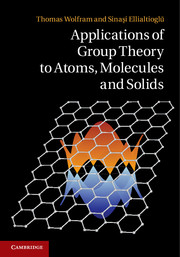Book contents
- Frontmatter
- Contents
- Preface
- 1 Introductory example: Squarene
- 2 Molecular vibrations of isotopically substituted AB2 molecules
- 3 Spherical symmetry and the full rotation group
- 4 Crystal-field theory
- 5 Electron spin and angular momentum
- 6 Molecular electronic structure: The LCAO model
- 7 Electronic states of diatomic molecules
- 8 Transition-metal complexes
- 9 Space groups and crystalline solids
- 10 Application of space-group theory: Energy bands for the perovskite structure
- 11 Applications of space-group theory: Lattice vibration
- 12 Time reversal and magnetic groups
- 13 Graphene
- 14 Carbon nanotubes
- Appendix A Vectors and matrices
- Appendix B Basics of point-group theory
- Appendix C Character tables for point groups
- Appendix D Tensors, vectors, and equivalent electrons
- Appendix E The octahedral group, O and Oh
- Appendix F The tetrahedral group, Td
- Appendix G Identifying point groups
- Index
- References
10 - Application of space-group theory: Energy bands for the perovskite structure
Published online by Cambridge University Press: 18 December 2013
- Frontmatter
- Contents
- Preface
- 1 Introductory example: Squarene
- 2 Molecular vibrations of isotopically substituted AB2 molecules
- 3 Spherical symmetry and the full rotation group
- 4 Crystal-field theory
- 5 Electron spin and angular momentum
- 6 Molecular electronic structure: The LCAO model
- 7 Electronic states of diatomic molecules
- 8 Transition-metal complexes
- 9 Space groups and crystalline solids
- 10 Application of space-group theory: Energy bands for the perovskite structure
- 11 Applications of space-group theory: Lattice vibration
- 12 Time reversal and magnetic groups
- 13 Graphene
- 14 Carbon nanotubes
- Appendix A Vectors and matrices
- Appendix B Basics of point-group theory
- Appendix C Character tables for point groups
- Appendix D Tensors, vectors, and equivalent electrons
- Appendix E The octahedral group, O and Oh
- Appendix F The tetrahedral group, Td
- Appendix G Identifying point groups
- Index
- References
Summary
In Chapter 9 nearly free-electron energy bands were discussed. In this chapter we discuss the energy bands of a crystal for which the electronic states are derived from atomic-like orbitals. For molecules this approach is the LCAO model. Applied to crystalline solids, it is referred to as the tight-binding model. In either case the wavefunctions are linear combinations of atomic-like orbitals. We shall analyze the energy bands of a class of perovskite oxides known as the d-band perovskites.
The structure of the ABO3 perovskites
We consider the cubic ABO3 oxides having the perovskite structure with the transition metal B ions. Examples include insulators, such as SrTiO3, BaTiO3, and KTaO3, and metals, such as NaWO3 and ReO3 (a perovskite without an A ion). The structure of these oxides is shown in Fig. 10.1. Many oxides (e.g., BaTiO3 and SrTiO3) undergo structural phase transitions at lower temperatures, leading to non-cubic lattices and ferroelectric and piezoelectric properties. Here we are concerned with the cubic phase.
As illustrated in Fig. 10.1, the B ions are at the center of a cube, the oxygen ions are on the faces of a cube, and the A ions are on the corners of a cube.
The five ions of the unit cell are labeled A, B, 2, 3, and 5 in Fig. 10.1. The origin is taken at the B site and the oxygen ions are located at a(1, 0, 0), a(0, 1, 0), and a(0, 0, 1).
- Type
- Chapter
- Information
- Applications of Group Theory to Atoms, Molecules, and Solids , pp. 280 - 303Publisher: Cambridge University PressPrint publication year: 2014



